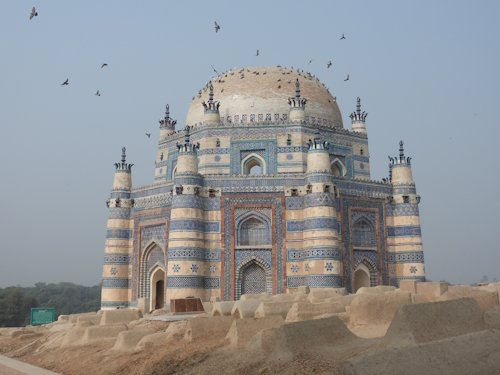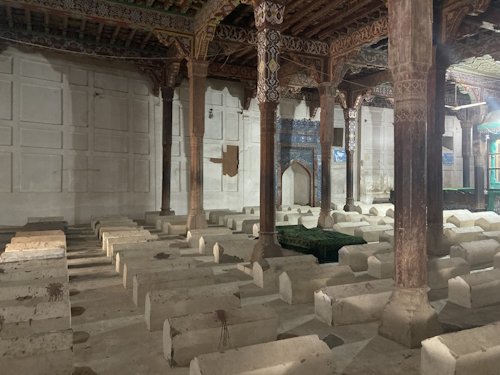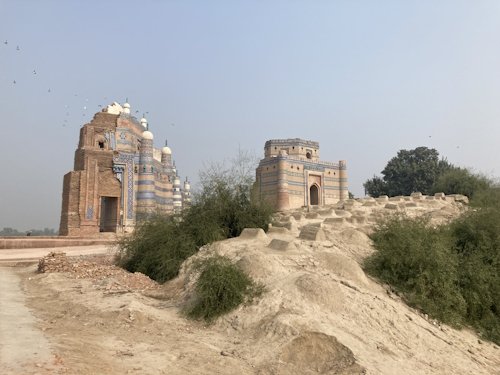Els Slots
Uch Sharif
The Monuments of Uch Sharif are on Pakistan’s Tentative List under the cumbersome name of ‘ Tomb of Bibi Jawindi, Baha'al-Halim and Ustead and the Tomb and Mosque of Jalaluddin Bukhari ’. They comprise a cluster of three stand-alone monumental tombs and a mosque-mausoleum in the town of Uch Sharif. They’re probably the most colourful sights you will encounter in Pakistan, and posting a photo of its iconic Bibi Jawindi tomb anywhere on social media will attract countless ‘likes’ from those who have never seen it.

Uch Sharif is considered the cradle of the ‘shrine worship culture’ that is still very present in today’s Pakistan. In the later Middle Ages, religious missionaries and scholars came from as far as Bukhara to Uch Sharif to convert local tribes to Islam. When they died, a tradition was started of veneration of their tombs and local people wanted to be buried close to them.
The four buildings of this ensemble stand together on a low hill adjacent to a river, which caused them severe flood damage in 1817. The compound has kept its original desert-like conditions and is mostly covered with small cemented graves.
The visit starts at the mosque, which already is a sight to behold. The ‘flat’ blue-tiled façade resembles those common in Uzbekistan, while the interior reminds of the Wooden Mosques of Anatolia, with painted wooden pillars ‘holding’ the roof. At the back is the entrance to the tomb of the 13th-century Sufi saint Jalaluddin Bukhari ; he was one of the Char Yaar (Four Friends) which also included the pioneering saints in Multan and Sehwan Sarif. It’s surrounded by many smaller tombs of his family members and followers. People still come here to pray.

In the courtyard, there’s a dovecote, which holds the hundreds of rock pigeons that you see swarming around the tombs. This tradition of keeping and releasing pigeons you will also find at other Sufi shrines in Pakistan, although its origins are unclear. Our quite simplistic tour guide came up with “because the people like it” for an answer, but there must be a more historical meaning here. It may be traced back to a Mughal obsession with pigeon keeping , or to a similar tradition as seen at Sufi shrines in Bangladesh where they are said to descend from a single pair given to a Sufi (as described here in one of the comments ).
Three separate octagonal tombs with bright blue and white mosaic tiles can be found in the upper area. In fact, despite the pretty pictures, these are half-empty eggshells – with a good side and a ‘bad’ side to look at after flooding seriously damaged them. The one for Bibi Jawindi (15th century) is the best preserved. Bibi Jawindi was the great-granddaughter of a famous Sufi saint. The other two tombs belong to Ustad Nuria (the architect of her tomb) and Baha'al-Halim (the earliest at the site, the saint revered by Bibi’s family).

After extensive restorations in recent years funded by the WMF, the US Ambassadors Fund and the World Bank , this site looks fully ready to be nominated for WH status. The wheels of bureaucracy in Pakistan run slow however (they’re still trying to push through Banbhore after 3 incomplete dossiers) and it seems - as on other topics - Pakistan is only holding itself back here, so who knows when it is finally going to happen? More strict Sunni Muslims have an aversion to this kind of ‘populist’ reverence of Sufi tombs, but it hasn’t prevented these (and the ones in Multan) from being placed on the Tentative List.
More on
Els SlotsComments
No comments yet.
